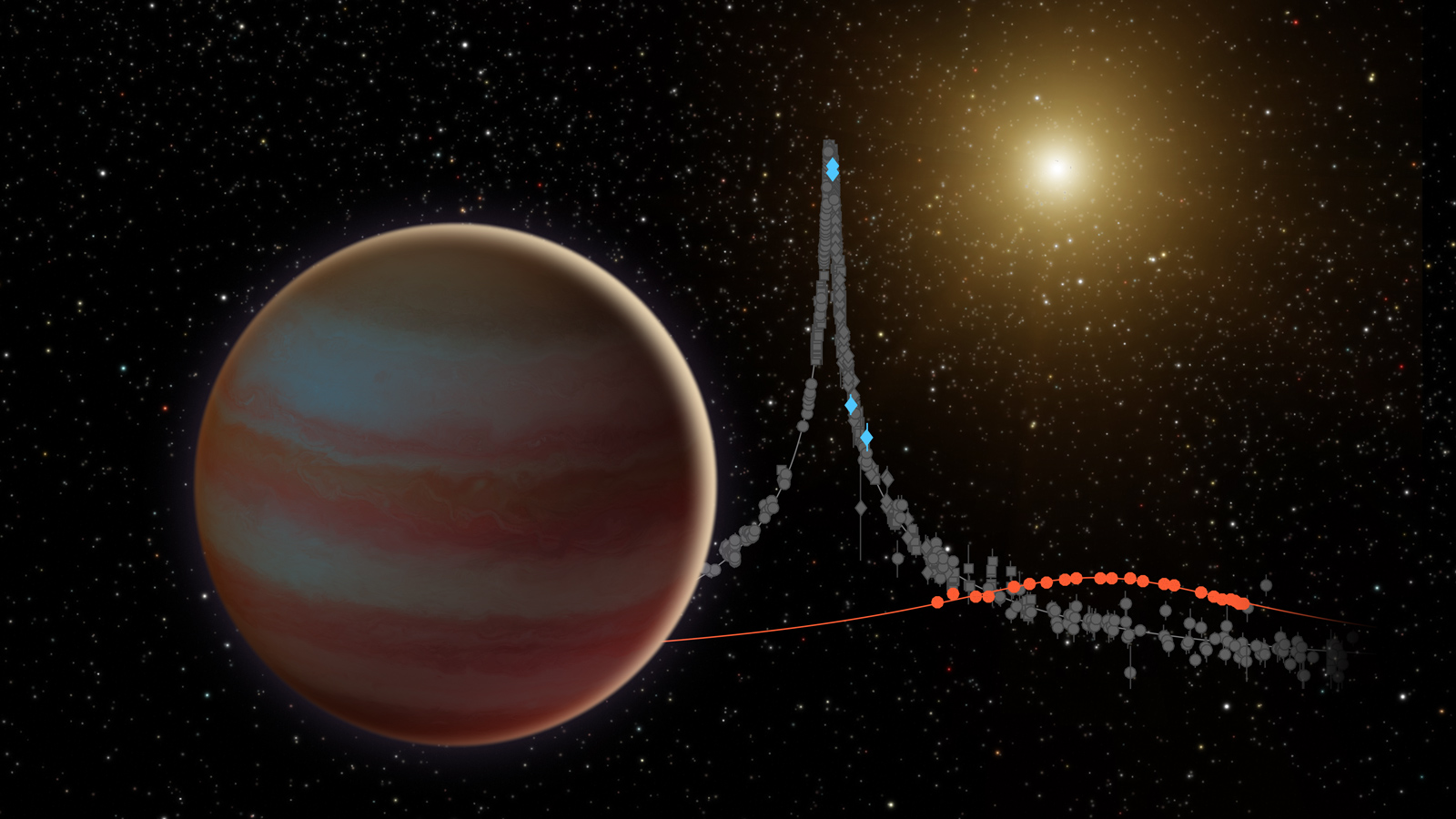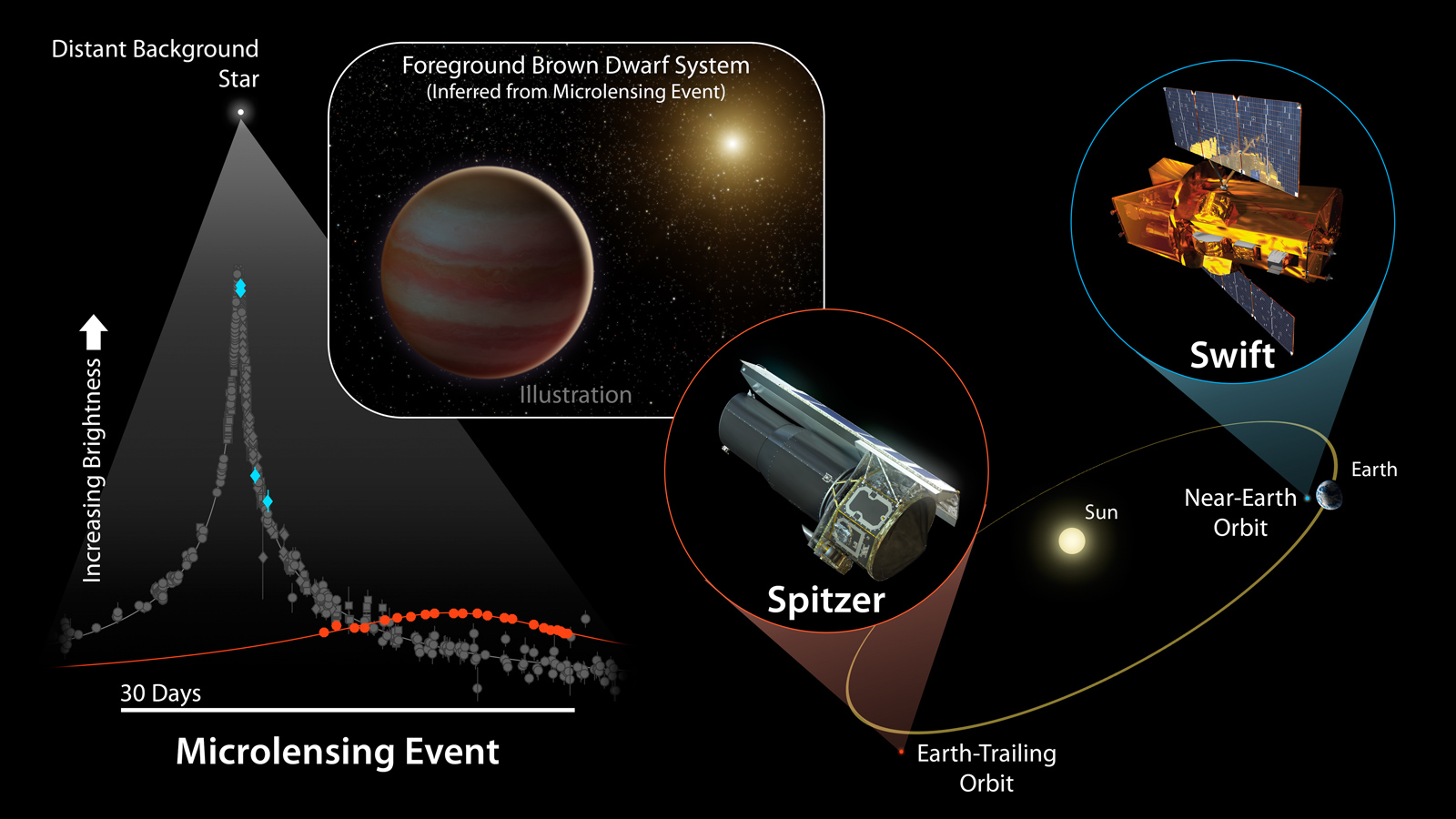Telescope Team-Up Holds Cosmic Lens to Rare Brown Dwarf

Two space telescopes' lucky perspectives have revealed an unusual brown dwarf that seems to be crowding close to a small star.
When a huge cloud of gas is pulled together by gravity, it can collapse down into a ball. Often, it becomes dense enough that the center bursts into nuclear fusion and that ball becomes a star. If it's not dense enough, but is close, it will instead become a ball of gas called a brown dwarf. Brown dwarfs can have orbiting systems of planets of their own at times, and they can also orbit stars. But for some reason, researchers rarely find a brown dwarf orbiting within three Earth-sun distances of a sun-mass star.
Now, due to a gravitationally lucky set of viewpoints — the first-ever such collaboration between two space telescopes — researchers have found one brown dwarf that might sit right in that "brown dwarf desert." [Brown Dwarfs: Strange Failed Stars of the Universe Explained (Infographic)]
"We want to understand how brown dwarfs form around stars and why there is a gap in where they are found relative to their host stars," Yossi Shvartzvald, lead author on the new work and researcher at NASA's Jet Propulsion Laboratory (JPL), said in a statement.
Two eyes are better than one
Researchers spotted the system, which is located about 16,000 light-years away from Earth toward the center of the Milky Way galaxy, as the brown dwarf's system passed in front of a background star that's even further from Earth's solar system.
Because of the way the two star systems were positioned, this led to an effect called microlensing: The light traveling from the faraway star bent around the nearer system, due to its gravity, which brought the star into brighter, distorted focus for Earth. The way the light focuses tells researchers about the intervening system's mass. An imperfection in how the light bends can indicate planets or other bodies in orbit around that star.
In this case, researchers looked at the system and background star from two different space telescopes: the Spitzer Space Telescope, which is following Earth in its own orbit around the sun — it's about 40 percent farther from Earth than Earth is from the sun — and the Swift X-ray observatory, which orbits Earth. Several ground-based telescopes observed the system, too, from a very similar perspective to Swift's.
Get the Space.com Newsletter
Breaking space news, the latest updates on rocket launches, skywatching events and more!
The two perspectives of the gravitational lens, both measured in the summer of 2015, gave scientists more details about the closer system — One viewpoint far away from Earth, from the Spitzer telescope, and one close by, from the ground telescopes and Swift.
"Anytime you have multiple observing locations — such as Earth and one, or in this case, two space telescopes — it's like having multiple eyes to see how far away something is," Shvartzvald said. "From models for how microlensing works, we can then use this to calculate the relationship between the mass of the object and its distance."

Distant dwarf
Using the data for how the background star brightened as its light bent around the intervening system, from those two different angles, the researchers found that the system hosted a brown dwarf between 30 and 65 times the mass of Jupiter. The brown dwarf orbits a small star, and is at a distance of either one-fourth the Earth-sun distance or 45 times that distance; the data could support either of those distances. If it's at one-fourth the Earth-sun distance, it's right in that "brown dwarf desert," where less than 1 percent of sun-like stars have a brown dwarf orbiting.
The observation is the first time two space telescopes have collaborated to analyze a microlensing event, officials from JPL said in the statement. It was also the first time the Swift telescope had observed microlensing, they said.
"In the future, we hope to have more observations of microlensing events from multiple viewing perspectives, allowing us to probe further the characteristics of brown dwarfs and planetary systems," Geoffrey Bryden, JPL scientist and co-author on the new study, said in the statement.
In the paper, the researchers discussed other microlensing scenarios where Swift could be helpful, including comparing its perspective to ground-based telescopes to investigate closer objects, like free-floating planets that don't orbit stars.
The new work was detailed Nov. 7 in The Astrophysical Journal.
Email Sarah Lewin at slewin@space.com or follow her @SarahExplains. Follow us @Spacedotcom, Facebook and Google+. Original article on Space.com.
Join our Space Forums to keep talking space on the latest missions, night sky and more! And if you have a news tip, correction or comment, let us know at: community@space.com.

Sarah Lewin started writing for Space.com in June of 2015 as a Staff Writer and became Associate Editor in 2019 . Her work has been featured by Scientific American, IEEE Spectrum, Quanta Magazine, Wired, The Scientist, Science Friday and WGBH's Inside NOVA. Sarah has an MA from NYU's Science, Health and Environmental Reporting Program and an AB in mathematics from Brown University. When not writing, reading or thinking about space, Sarah enjoys musical theatre and mathematical papercraft. She is currently Assistant News Editor at Scientific American. You can follow her on Twitter @SarahExplains.









